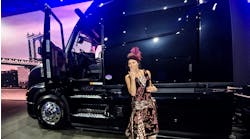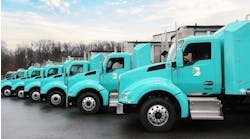With all the emphasis today on improved fuel economy, energy conservation, environmental protection and enhanced vehicle functionality, commercial truck and component manufacturers have been busy developing "green" technologies. Increasingly, fleets are adopting hybrid and hybrid electric technology.
Vehicle fleet managers understand that delivery and transportation are the lifelines of any business. These managers are under constant pressure to lower operational costs without sacrificing performance and durability.
The performance characteristics of hybrid electric vehicles are enticing, and the tough duty cycle of a commercial vehicle is the ideal application to experience the full range of benefits from hybrid electric technology. For example, many commercial vehicles experience frequent idle time, such as school buses or delivery trucks at a drop-off. Hybrid electric offers engine-off at idle which can significantly reduce fuel and emissions, while still having the hybrid system support ancillary vehicle applications like climate control.
Depending on the application, hybrid electric truck users can experience an improvement of 30 to 35 percent in fuel economy compared to a traditional diesel-engine powered truck in a variety of operations. In an increasingly "green" world, the hybrid electric also reduces green house emissions by a wide margin.
Hybrid electrics provide other benefits. Along with extending engine life, hybrid systems assist in deceleration through regenerative braking, reducing brake wear, resulting in lower maintenance and lifecycle costs. The clean, quiet operation of hybrid electric vehicles are particularly suitable for those applications that require power takeoffs (PTO) to operate tools and equipment, where non-hybrid vehicles would otherwise be idling normally and exposing surrounding areas and vehicle operators to excessive noise and diesel exhaust for extended periods.
While hybrid electric technology itself presents a compelling story, there are external factors that are also helping to set the stage for accelerated growth in the commercial sector. Among these are access to government stimulus money, the threat of higher oil prices, greater recognition and appreciation for environmental issues and better understanding of hybrid technology in general.
SYSTEMS OVERVIEW
Hybrid electric systems combine an engine with a combination electric motor/generator and high-capacity batteries to augment engine torque with electrical motor torque, say officials at Eaton Corporation, a global technology leader in electrical components and systems, including truck and automotive drivetrain and powertrain systems for performance, fuel economy and safety. Advanced powertrain controls monitor driving conditions and automatically select the ideal power mode, smoothly switching among electric only, combined diesel and electric and diesel-only power modes.
The hybrid drive system recovers energy normally lost during braking and stores this energy in the hybrid system's batteries, Eaton officials explain. This technology is called regenerative braking.
During the next vehicle launch cycle, this electric energy is pulled from the batteries and supplied to the hybrid motor, which converts the electric energy to torque and horsepower, continue the officials. When blended with engine torque, the stored energy is used to improve fuel economy and vehicle performance.
The main components of a parallel electric hybrid drive system are the diesel engine; hybrid drive unit (HDU) - electric motor and automated manual transmission; power electronics carrier (PEC), commonly referred to as the battery box; motor inverter controller; hybrid cooling system; DC/DC converter for ePTO (electrical power takeoff) application only; and battery charger.
Among the truck manufacturers currently offering a range of hybrid electric drive trucks are Freightliner, International, Kenworth and Peterbilt - all with systems that are supplied by Eaton.
PARALLEL DIESEL
It bears mentioning that last year, Mack Trucks delivered a diesel-electric hybrid Mack TerraPro Low Entry model refuse truck to the city of New York. It is the first production intent parallel diesel-electric hybrid truck in the U.S. designed specifically for Class 8 heavy duty applications and meeting the U.S. EPA's 2010 diesel emission regulations.
The Mack diesel-electric hybrid powertrain features an integrated tarter, alternator and electric motor. The system captures energy from braking in the form of electricity (regenerative braking), stores the electricity in a 600-volt lithium ion battery pack and uses it to power the electric motor, which assists the Mack MP7 diesel engine with propulsion of the truck.
The Mack system is what is known as a parallel hybrid because the diesel engine and electric motor can operate either in unison or as separate units. There are three possible modes: pure diesel power, such as at highway speeds; pure electric power, useful for quiet operations in residential neighborhoods; and combined diesel-electric mode, when maximum power is desired, such as accelerating from a stop with a full load.
The combined diesel-electric mode improves performance and requires less fuel than diesel-only.
When the parallel hybrid vehicle decelerates, electric energy is returned to the battery pack using the same hybrid system.
DRIVE TECHNOLOGY
Azure Dynamics Corporation is a company that develops electric and hybrid electric drive technology for light to medium duty commercial vehicles. It offers a range of hybrid systems, including its Balance Hybrid Electric drive system on Ford E450 cutaway and strip chassis trucks.
This system, which manages the conventional 5.4-liter Triton gasoline engine and 5-speed automatic TorqShift transmission, features electric-launch assist, engine-off at idle and regenerative braking, all of which combine to improve fuel economy and reduce idling for fewer greenhouse gas emissions, explains Bill Nash, Azure Dynamics' product support manager.
This hybrid system runs on either the electric motor or the gas engine. Output to the drive wheels is through a common driveshaft. Although the gas engine will start and run at the beginning of a daily work cycle, it will shut off automatically after warm up.
The vehicle operates on the electric motor at speeds below about 25 mph with the gas engine starting automatically as needed for high-voltage battery charging or acceleration demands. At highway speeds, the gas engine provides driving power and continues to charge the high-voltage battery pack as needed.
Azure Dynamics' CitiBus product is a series hybrid electric system on a Workhorse chassis that comes in a gas or diesel version. In this type of system, the conventional transmission and driveline is replaced with an electric motor to drive the rear wheels. The engine is not coupled directly to the drive wheels and serves only to power a generator to charge the high-voltage battery back which powers the electric motor. On deceleration, the electric drive motor serves as a generator and converts rolling energy into high-voltage battery charging ability.
Regenerative energy is stored in the high-voltage battery. This energy is reused by the electric motor while driving the vehicle. When the vehicle comes to a stop, the engine will often shut off, Nash explains. When this happens, the energy stored in the battery pack runs the auxiliary drives, such as the power assist systems (brakes and power steering), electric air conditioning system and the DC/DC converter which charges the 12-volt batteries.
This CitiBus also has the capability to start the engine and charge the high-voltage battery using the generator or to start the engine with the 12-volt starter as a back-up.
Another product is the Force Drive battery electric drivetrain which will be integrated on the Ford 2010 Transit Connect van - a full electric, plug-in system that is much less complex systems than other hybrid systems, says Nash. According to Ford, the Transit Connect BEV model has a targeted range of 80 miles minimum on a full charge and zero tailpipe emissions.
The Low Emission Electric Power (LEEP) from Azure Dynamics are compact hybrid systems that basically run off a vehicle's transmission's power takeoff to generate and capture clean electric power to supply a range of auxiliary systems and export power applications. The system requires little power, about the equivalent of running a cab air conditioner.
Kidron's Ultra Temp hybrid refrigeration solution for refrigerated distribution incorporates the LEEP system to deliver efficient power refrigeration while cutting fuel consumption and emissions by 90 percent, says Kidron.
The power generated is stored in the refrigeration system. When the vehicle engine is shut down, the stored energy of Ultra Temp maintains the cargo area temperature. Overnight, the Ultra Temp system can be plugged into either single or three-phase power sources, eliminating cost, fuel, noise and emissions from diesel engines and generators.
For the most part, hybrid vehicles operate just like any traditional vehicles, say Azure Dynamics and Eaton officials. However, the operator will have to get used to the quieter operation.
PREVENTATIVE MAINTENANCE
Eaton suggests service and maintenance professionals should be aware of a few distinct service procedures which, when adhered to, will go a long way to ensuring clean, reliable service. In conjunction with its OEM partners, Eaton outlines five keys to PM success for operations that have hybrid electric trucks.
• Check transmission lube - The transmission lube fill and drain plugs are located on the right side of the transmission main case. Eaton recommends checking the lube level at every vehicle PM interval.
The lube should be level with the bottom of the fill-plug hole. If it is not level, only approved CD-50 synthetic lubricant should be used to refill.
• Grease the clutch release shaft bushing - Also with every PM interval, Eaton advises that a couple of pumps of grease be applied to the zerks of the upper cross shaft bushing. These are located at the bottom of the clutch housing at the inspection cover. Early built units have the zerk fitting on the top of the housing.
• Change the PEC air filter - The air filter on the power electronics carrier (battery box) needs to be checked - and changed if needed - a minimum of every four months, says Eaton. The PEC is an air cooler unit that uses an electric fan to pull air through the filter, then over the batteries and electronic components inside the housing. Plugged air filters will reduce hybrid assist and reduce fuel economy.
• Check hybrid liquid cooling level - Eaton hybrid electric systems also have a cooling system that is separate from the diesel engine's cooling system. Yet, the coolant type and flush interval should be the same as the diesel engine's system.
Eaton advises that service professionals should also visually check the coolant level on a regular basis. The coolant should be between "½" and "¾" on the sight glass of the reservoir. If it is not, approved coolant needs to be added.
• Visual inspections - High-voltage wiring and connections also should be visually checked at every PM interval. Eaton says proper training and equipment is needed to repair high-voltage cables showing signs of damage or incorrect routing, and only a certified OEM dealer should be used to make the repairs.
SAFETY MEASURES
Eaton and Azure Dynamics both say they place a very high priority on making hybrid systems as safe as possible. All of the components were selected and specified to provide safety for not only the driver, but also for any technician who might be working on the vehicle, and even for motorists and others who might be involved in an accident with a hybrid vehicle, Eaton points out.
With Eaton hybrid electric systems, all high-voltage components are totally isolated from the vehicle chassis, and high-voltage cables were purposely placed outside of the vehicle's cab and enclosed to safeguard the operator and passengers. High-voltage cables and connectors are bright orange - a color that signals caution to trained technicians, as well as emergency response professionals and others who may respond to an accident.
In addition, regenerative braking and anti-lock braking systems (ABS) are linked via the SAE J1939 datalink so that that the hybrid system does not have any negative impact on the vehicle during an ABS event.
Both Eaton and Azure Dynamics have extended their hybrid safety initiatives beyond vehicle design and driver training. The companies work closely with OEMs to support all their products. Safety information for vehicle operators is included in vehicle owner's guides, and service manuals provide detailed coverage for service technicians.
Training on hybrid systems is also made available to independent maintenance and repair shops.
As with any type of automotive systems, technicians need to be properly trained on hybrid vehicles and need to use the proper tools and safety equipment, adds Azure Dynamics' Nash. These include specific diagnostic tools, special high-voltage electrical safety insulating gloves and a minimum 500-volt AC voltmeter.



